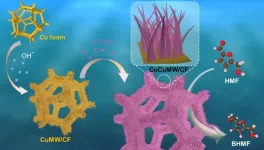(Press-News.org) At a glance:
Researchers discovered the importance of an enzyme that promotes growth of certain lung cancers.
The enzyme, GUK1, supports metabolism in cancer cells to help tumors grow.
In the future, GUK1 could become a possible target for lung cancer therapies.
Lung cancer is a particularly challenging form of cancer. It often strikes unexpectedly and aggressively with little warning, and it can shapeshift in unpredictable ways to evade treatment.
While researchers have gleaned important insights into the basic biology of lung cancer, some of the disease’s molecular maneuvers have remained elusive.
Now, a team led by scientists at Harvard Medical School has made strides in understanding how a genetic flaw in some lung cancers alters cancer cell metabolism to fuel the disease.
Working with mouse models and human cancer cells, the researchers identified a metabolic enzyme called GUK1 in lung cancers harboring an alteration in the ALK gene. Their experiments showed that GUK1 plays an important role in boosting metabolism in tumor cells to help them grow.
The findings, reported Feb. 6 in Cell and supported in part by federal funding, provide a clearer picture of how metabolism works in lung cancer.
The research could set the stage for developing therapies that target GUK1 to curb cancer growth, the team said.
Lung cancer: A formidable foe
As a thoracic oncologist at Massachusetts General Hospital, co-first author Jaime Schneider regularly treats patients with lung cancer, and sees firsthand how aggressive and persistent the disease can be.
“A huge percentage of patients I see in the clinic do well for some period of time on the currently available therapies, but eventually relapse,” said Schneider, who is also an instructor of medicine in cell biology at HMS.
Lung cancer is the leading cause of cancer deaths in the United States and worldwide, and, Schneider noted, cases are increasing among never-smokers and former light smokers for reasons that remain poorly understood.
Schneider’s patients — many of whom donated tumor samples for the study — inspired her to learn more about the molecular underpinnings of the disease.
“We need to be thinking outside the box to gain a better understanding of disease biology in lung cancer, and to identify new therapeutic targets,” she said.
Schneider joined the lab of senior author Marcia Haigis, a professor of cell biology in the Blavatnik Institute at HMS, who studies how metabolic shifts can accelerate aging and drive disease. While working in the Haigis lab, Schneider connected with co-first author Kiran Kurmi, then a research fellow who has a background in biochemistry and cancer cell signaling.
Cancer cells must change their metabolism in order to continue growing and surviving amid attacks mounted by the immune system and cancer treatments, Haigis explained.
“Our goal was to understand how specific cancer gene aberrations might directly rewire metabolic pathways to enable cancer growth,” she said.
Haigis deems cancer metabolism an emerging area in cancer research, and one that could inform the design of a new generation of precision cancer therapies targeted directly at the cellular processes that ignite tumor growth.
Metabolic detectives on the case
The researchers set out to study lung cancers caused by an alteration in the ALK gene that leads to the production of an abnormal ALK protein. First, they screened the metabolic proteins present in these ALK-positive cancers, and identified GUK1 as one of particular interest.
“We were really intrigued by what the interaction between ALK and GUK1 means — and like metabolic detectives, that’s what we followed,” Haigis said.
Next, they conducted a series of experiments in mice and patient-derived cancer cells to explore GUK1’s contribution to metabolic changes in ALK-positive cancer cells.
The scientists determined that GUK1 is an enzyme that helps abnormal ALK proteins make a molecule called GDP, a precursor to the energy-rich molecule GTP that cancer cells need for tasks such as dividing and making proteins. When the researchers disabled GUK1, cancer cell growth slowed considerably, suggesting that ALK-positive cancers become highly dependent on this enzyme as their molecular fuel for mischief.
“GUK1 turned out to be a metabolic liability in this subset of lung cancer that facilitates tumor growth and survival,” Schneider said.
The team also found evidence of elevated GUK1 levels in additional subtypes of lung cancer, suggesting that the enzyme may play a role in lung cancers driven by other genetic defects.
“By focusing on the basic biology of lung cancer, we were able to identify a new metabolic mechanism that is important in the disease,” Haigis said.
Just the beginning
The researchers note there is a lot more to be uncovered about GUK1 in cancer. They are interested in exploring how many types of cancer are driven by GUK1 in some way. They also want to understand in greater detail how inhibiting GUK1 affects cancer cells. Finally, given that many patients with lung cancer eventually relapse, they want to study whether and how GUK1 helps cancer cells metabolically reprogram themselves to sidestep treatment.
If GUK1 is indeed a key enzyme that gives various cancers the metabolic boost they need to grow quickly and persistently, it could be a compelling target for new cancer therapies.
“We hope that identifying distinct metabolic vulnerabilities like GUK1 will open up new avenues for therapeutic targeting in cancer patients in the future,” Schneider said.
Authorship, funding, disclosures
Additional authors on the paper include Yutong Dai, Ishita Dhiman, Shakchhi Joshi, Brandon Gassaway, Christian Johnson, Nicole Jones, Zongyu Li, Christian Joschko, Toshio Fujino, Joao Paulo, Satoshi Yoda, Gerard Baquer, Daniela Ruiz, Sylwia Stopka, Liam Kelley, Andrew Do, Mari Mino-Kenudson, Lecia Sequist, Jessica Lin, Nathalie Agar, Steven Gygi, Kevin Haigis, and Aaron Hata
The study was funded by the National Institutes of Health (R01CA240317; R01CA164273), the National Institutes of General Medical Sciences (R01GM132129; GM67945), the National Cancer Institute (R01CA273461; U01CA267827), the Joslin Diabetes Center, the Ludwig Center at HMS, A Breath of Hope Lung Foundation, the Lung Cancer Research Foundation, an American Cancer Society Institutional Research Grant, the Life Sciences Research Foundation, and K12CA087723.
Schneider has received honoraria from the Academy of Continued Healthcare Learning, Springer Healthcare, Targeted Oncology, Total Health Conferencing, DAVA Oncology, Physicians’ Education Resource; travel from Dava Oncology; research funding from Gilead. Mino-Kenudson has royalties from Elsevier; Consulting for AstraZeneca, Bristol Myers Squibb, Sanofi, Roche, Boehringer Ingelheim, Innate, Daiichi-Sankyo, and AbbVie. Fujino has a research grant from Takeda Science Foundation, Eli Lilly Japan K.K., Nuvalent, Inc., and Kinnate Biopharma Inc. outside the submitted work; and a patent for KU220115PCT pending. Sequist has institutional research funding from AstraZeneca, Novartis, and Delfi diagnostics. Gygi is a member of the scientific advisory board of Cell Signaling Technologies and ThermoFisher Scientific. Hata has grant/research support from Amgen, Blueprint Medicines, BridgeBio, Bristol-Myers Squibb, C4 Therapeutics, Eli Lilly, Novartis, Nuvalent, Pfizer, Roche/Genentech, and Scorpion Therapeutics; Consulting/advising for Engine Biosciences, Nuvalent, Oncovalent, TigaTx, and Tolremo Therapeutics. Lin has received institutional research funding from Hengrui Therapeutics, Turning Point Therapeutics, Novartis, Neon Therapeutics, Bayer, Roche/Genentech, Pfizer, Elevation Oncology, Relay Therapeutics, Linnaeus Therapeutics, Nuvalent; honorarium or consulting fees from Genentech, C4 Therapeutics, Blueprint Medicines, Nuvalent, Bayer, Elevation Oncology, Novartis, Mirati Therapeutics, Regeneron, Pfizer, Takeda, Ellipses Pharma, Hyku BioSciences, AnHeart Therapeutics, Claim Therapeutics, Merus, Bristol Myers Squibb, Daiichi Sankyo, AstraZeneca, Yuhan, and Turning Point Therapeutics; and travel fees from Pfizer and Merus. K. Haigis receives research funding from TUQ Therapeutics and Revolution Medicines. M. Haigis is on the scientific advisory board for MitoQ, Alixia Therapeutics, Minovia, is a scientific founder and a consultant for Refuel Bio, and receives unrelated research funding from Refuel Bio.
END
Research pinpoints weakness in lung cancer’s defenses
Scientists uncover an enzyme that boosts cancer cell metabolism to fuel growth
2025-02-10
ELSE PRESS RELEASES FROM THIS DATE:
New study highlights healthcare utilization shifts among Long COVID patients in Colorado after diagnosis
2025-02-10
AURORA, Colo. (Feb 10, 2025) – A new study analyzing Long COVID healthcare utilization in Colorado reveals a significant shift from acute care to outpatient services following diagnosis, shedding light on evolving treatment patterns and the broader healthcare burden posed by the condition.
The study, published today in BMC Public Health, was conducted using Colorado’s comprehensive All-Payer Claims Database and provides one of the most detailed population-level insights into Long COVID patients to date. Researchers examined utilization patterns of individuals diagnosed with Long COVID between October 2021 and August 2022, tracking them for one-year post-diagnosis.
“The ...
Majority of kids who die in mass shootings killed by family members, Stanford Medicine-led study shows
2025-02-10
When U.S. children die in mass shootings, most of the time the perpetrator is a family member, new Stanford Medicine-led research shows.
The findings, which will be published online Feb. 10 in JAMA Pediatrics, come from the first analysis of the relationships between mass shooting perpetrators and pediatric victims, those who are younger than 18 years old.
“It was surprising that domestic violence was so pervasive, that 59% of kids who died in mass shootings were at the hands of a family member,” said ...
How perception may shape health safety-related assessments
2025-02-10
Perceiving whether another person is a personal health risk requires quickly assessing their trustworthiness. With limited characteristics available, implicit assumptions often influence risk perception. Research in this area has pointed to brain regions that may be involved in perceiving others as untrustworthy or as carriers of sexually transmitted diseases (STDs). However, the relationship between brain activity, perceived trustworthiness of others, and perceived likelihood of acquiring an STD was unclear prior to a recent study published in eNeuro. In the study led by Daniela Mier at ...
Potential new strategy for relieving anxiety
2025-02-10
Understanding the neural circuits that drive anxiety may help researchers discover circuit-specific targets and therefore increase the precision of treatment strategies. Previous studies have separately suggested that increased serotonin levels and the cerebellum may play roles in anxiety. To explore the relationship between these ideas, Pei Chin, from the University of Pennsylvania, and George Augustine, from Temasek Life Sciences Laboratory, probed whether serotonin in the cerebellum causes anxiety behavior in mice. Contrary to previous ...
Scientists develop corrosion-induced electrodes for biomass upgrading
2025-02-10
A research team led by Prof. ZHANG Jian from the Ningbo Institute of Materials Technology and Engineering (NIMTE) of the Chinese Academy of Sciences (CAS) has utilized metal corrosion to prepare high-performance electrodes, enabling efficient and cost-effective upgrading of bio-based 5-hydroxymethylfurfural (HMF). This study was published in Chem Catalysis.
Corrosion is a common phenomenon that can lead to material failure and economic losses. However, researchers are exploring its potential for beneficial applications, particularly in biomass upgrading.
Biomass is among the most abundant renewable resources on earth. Through catalytic conversion, ...
Contemporary hormonal contraception and risk of venous thromboembolism
2025-02-10
About The Study: This study showed venous thromboembolism (VTE) risk variation across hormonal contraceptives with highest rates for combined pills, especially those containing third-generation progestins, and no significant difference in risk for intrauterine devices (IUDs) relative to no use. For patches and implants, the increased VTE risk was uncertain due to limited data. Variation in VTE risk across products underscores the importance of personalized contraceptive counseling.
Corresponding Author: To contact the corresponding author, Harman Gailan Hassan Yonis, MD, email harman@live.dk.
To ...
Victim-shooter relationships in mass shootings involving child victims
2025-02-10
About The Study: The findings of this study indicate that from 2009 through 2020, a child was most likely to be killed in a mass shooting by a parent or family member, rather than a stranger or a peer. While school shootings dominate media coverage, this study suggests that domestic violence plays a larger role in child mass shootings.
Corresponding Author: To contact the corresponding author, Stephanie Chao, MD, email sdchao1@stanford.edu.
To access the embargoed study: Visit our For The Media website at this link https://media.jamanetwork.com/
(doi:10.1001/jamapediatrics.2024.6609)
Editor’s ...
Health care company payouts favor shareholders, new research shows
2025-02-10
It’s widely recognized that health care is a growing expense for many Americans. However, what health care companies do with their profits — some made through government programs such as Medicare — remains murky.
To investigate this question, researchers at Yale School of Medicine (YSM) analyzed financial reports from 92 large U.S. health care companies. The results were published on Feb. 10 in a research letter in JAMA Internal Medicine.
The research team focused on U.S. health care companies on the Standard & Poor’s 500 (S&P 500), which follows the 500 largest companies traded on stock exchanges, to ...
Glucose-lowering medications and risk of COPD exacerbations in patients with type 2 diabetes
2025-02-10
About The Study: The results of this comparative effectiveness research study suggest that sodium-glucose cotransporter-2 inhibitors and glucagon-like peptide-1 receptor agonists (GLP-1RAs) were associated with a reduced risk of moderate or severe chronic obstructive pulmonary disease (COPD) exacerbations compared with dipeptidyl peptidase 4 inhibitors in adults with type 2 diabetes and active COPD. This may inform prescribing of glucose-lowering medications among patients with type 2 diabetes and active COPD.
Corresponding Author: To contact the corresponding author, Elisabetta Patorno, MD, DrPH, email epatorno@bwh.harvard.edu.
To access ...
Low to moderate prenatal alcohol exposure and facial shape of children at ages 6 to 8
2025-02-10
About The Study: Low to moderate prenatal alcohol exposure was associated with characteristic changes in the faces of children, which persisted until at least 6 to 8 years of age. A linear association between alcohol exposure levels and facial shape was not supported.
Corresponding Author: To contact the corresponding author, Evelyne Muggli, MPH, email evi.muggli@mcri.edu.au.
To access the embargoed study: Visit our For The Media website at this link https://media.jamanetwork.com/
(doi:10.1001/jamapediatrics.2024.6151)
Editor’s Note: Please see the article for additional information, including other authors, ...
LAST 30 PRESS RELEASES:
Tracing the quick synthesis of an industrially important catalyst
New software sheds light on cancer’s hidden genetic networks
UT Health San Antonio awarded $3 million in CPRIT grants to bolster cancer research and prevention efforts in South Texas
Third symposium spotlights global challenge of new contaminants in China’s fight against pollution
From straw to soil harmony: International team reveals how biochar supercharges carbon-smart farming
Myeloma: How AI is redrawing the map of cancer care
Manhattan E. Charurat, Ph.D., MHS invested as the Homer and Martha Gudelsky Distinguished Professor in Medicine at the University of Maryland School of Medicine
Insilico Medicine’s Pharma.AI Q4 Winter Launch Recap: Revolutionizing drug discovery with cutting-edge AI innovations, accelerating the path to pharmaceutical superintelligence
Nanoplastics have diet-dependent impacts on digestive system health
Brain neuron death occurs throughout life and increases with age, a natural human protein drug may halt neuron death in Alzheimer’s disease
SPIE and CLP announce the recipients of the 2025 Advanced Photonics Young Innovator Award
Lessons from the Caldor Fire’s Christmas Valley ‘Miracle’
Ant societies rose by trading individual protection for collective power
Research reveals how ancient viral DNA shapes early embryonic development
A molecular gatekeeper that controls protein synthesis
New ‘cloaking device’ concept to shield sensitive tech from magnetic fields
Researchers show impact of mountain building and climate change on alpine biodiversity
Study models the transition from Neanderthals to modern humans in Europe
University of Phoenix College of Doctoral Studies releases white paper on AI-driven skilling to reduce burnout and restore worker autonomy
AIs fail at the game of visual “telephone”
The levers for a sustainable food system
Potential changes in US homelessness by ending federal support for housing first programs
Vulnerability of large language models to prompt injection when providing medical advice
Researchers develop new system for high-energy-density, long-life, multi-electron transfer bromine-based flow batteries
Ending federal support for housing first programs could increase U.S. homelessness by 5% in one year, new JAMA study finds
New research uncovers molecular ‘safety switch’ shielding cancers from immune attack
Bacteria resisting viral infection can still sink carbon to ocean floor
Younger biological age may increase depression risk in older women during COVID-19
Bharat Innovates 2026 National Basecamp Showcases India’s Most Promising Deep-Tech Ventures
Here’s what determines whether your income level rises or falls
[Press-News.org] Research pinpoints weakness in lung cancer’s defensesScientists uncover an enzyme that boosts cancer cell metabolism to fuel growth



